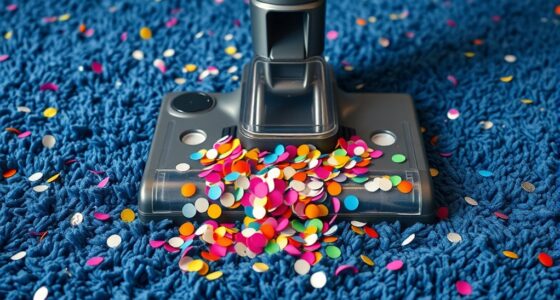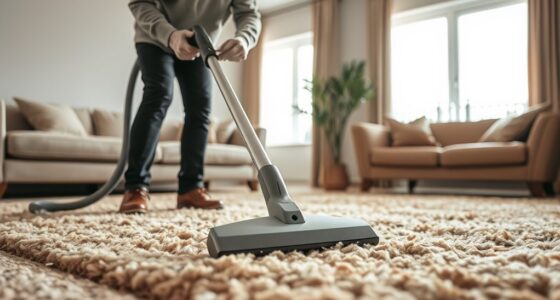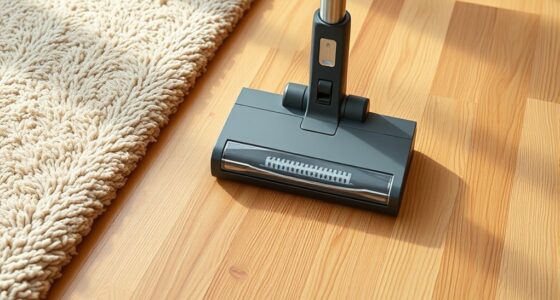To vacuum antique floors without scratching, use a vacuum with soft brush attachments and low suction settings. Clear loose dirt with a soft cloth or broom first, then move slowly and gently with deliberate strokes. Keep the vacuum in good condition to avoid abrasive debris and test on a small area before cleaning the entire floor. If you want to learn more about preserving your vintage floors, keep exploring proven techniques and expert tips.
Key Takeaways
- Use vacuums with soft brush attachments and gentle suction settings to prevent surface scratches.
- Move slowly and deliberately with smooth sweeping motions to minimize wear and surface damage.
- Before vacuuming, remove loose debris with soft tools like microfiber cloths or brooms.
- Regularly clean and maintain vacuum equipment to avoid dirt buildup that could scratch floors.
- Protect floors further by applying sealants, using furniture pads, and avoiding harsh chemicals during cleaning.
Understanding the Importance of Gentle Cleaning for Antique Floors
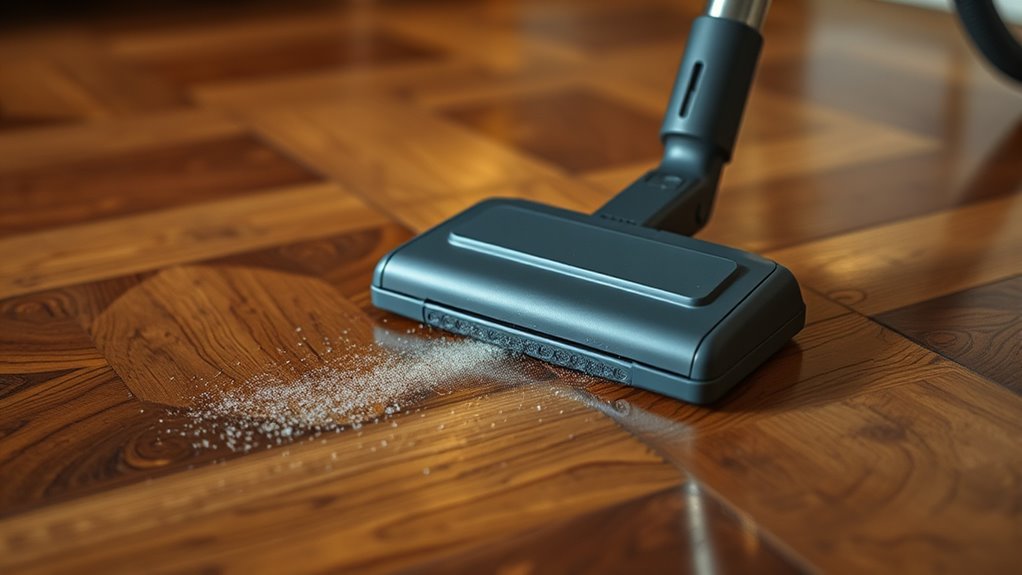
Because antique floors are often delicate and prone to damage, understanding the importance of gentle cleaning is essential. Using harsh methods or abrasive tools can harm the wood and compromise its integrity, making preservation difficult. Gentle cleaning helps maintain the floor’s original beauty and supports historical preservation, ensuring these historical features last for future generations. When you focus on soft cleaning techniques, you reduce the risk of scratches and wear that could otherwise necessitate costly floor refinishing. Regular, careful vacuuming removes dirt and debris without disturbing the delicate surface. This approach preserves the integrity of the wood, allowing you to enjoy the antique’s charm while respecting its historical significance. Additionally, understanding automation in business can help implement efficient cleaning systems that preserve antique floors more effectively. Gentle cleaning is a crucial step in caring for and maintaining antique floors over time.
Choosing the Right Vacuum Cleaner and Attachments
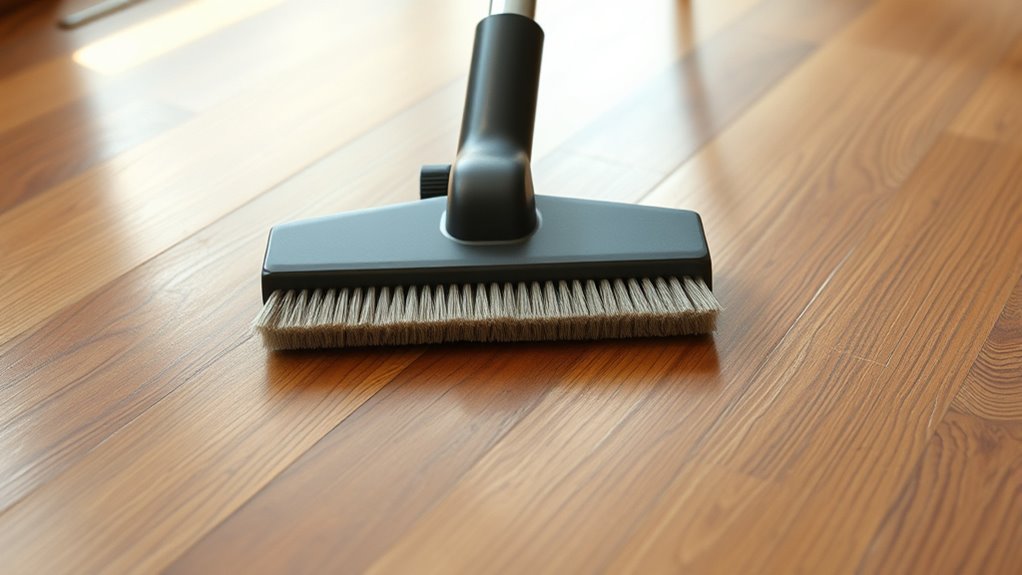
Selecting the right vacuum cleaner and attachments is essential for effectively cleaning antique floors without causing damage. You want a vacuum designed for delicate surfaces, so focus on models that offer gentle suction and soft brush options. Check for attachment compatibility to ensure you can use soft dusting brushes or microfiber pads that won’t scratch or scuff the floor’s finish. Proper vacuum maintenance, including regular filter and brush cleaning, keeps your machine functioning smoothly and prevents debris buildup that could harm your floors. Avoid vacuums with rough or abrasive parts, and opt for lightweight models that offer precise control. By choosing the right equipment, you protect your antique floors while maintaining their beauty and integrity during every cleaning session.
Preparing Your Antique Floors Before Vacuuming
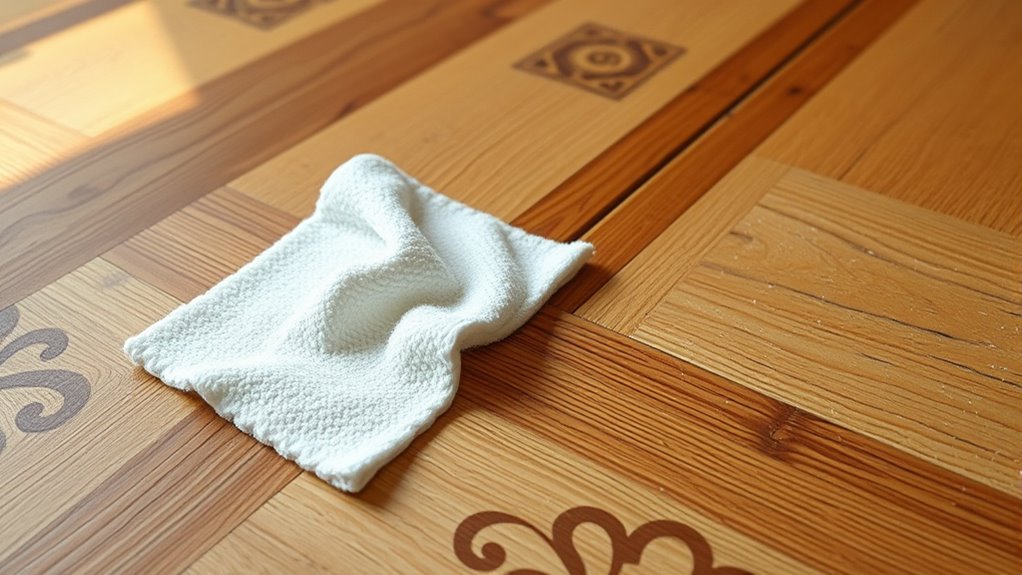
Before vacuuming your antique floors, start by removing any surface debris to prevent scratching. Check for loose boards and secure them to avoid damage during cleaning. Taking these steps guarantees your floors stay beautiful and intact. Additionally, using a vacuum with appropriate attachments, such as a soft upholstery brush or dusting brush, can help clean without harming the delicate surface.
Clear Surface Debris
Have you ever noticed how surface debris can hinder a thorough vacuuming of antique floors? Before you start, clear away loose dirt, dust, and small objects to prevent scratches. Removing debris ensures the vacuum’s gentle brush rolls can work effectively without snagging or spreading grime. This step also helps with floor polishing, as a clean surface enhances the shine and preserves the finish. Additionally, clearing debris makes stain removal easier later, since dirt particles won’t embed into the wood or stone. Use a soft broom or microfiber cloth to sweep away loose particles carefully. Taking this extra moment safeguards your antique floors, keeps them looking their best, and ensures that your vacuuming process is both efficient and scratch-free. Proper wall organization can also help keep debris contained and prevent it from settling into hard-to-reach areas, further protecting your floors.
Secure Loose Boards
If you notice any loose or creaking boards on your antique floor, it’s vital to secure them before vacuuming. Ensuring board stability prevents damage to both the floor and your vacuum. You can improve stability by:
- Applying nail reinforcement to loosened boards
- Using wood filler or adhesive to secure small gaps
- Checking for and tightening any visible nails or screws
- Choosing durable materials like reclaimed wood or ceramic for repairs can also enhance longevity and stability.
These steps help maintain the floor’s integrity and prevent further looseness. Focus on firmly securing loose boards to avoid accidental lifting or damage during cleaning. Remember, loose boards can cause scratches or gouges if left unchecked. Taking time to reinforce and stabilize ensures your vacuuming process remains gentle and safe, preserving the antique character of your floors.
Techniques for Gentle and Effective Vacuuming
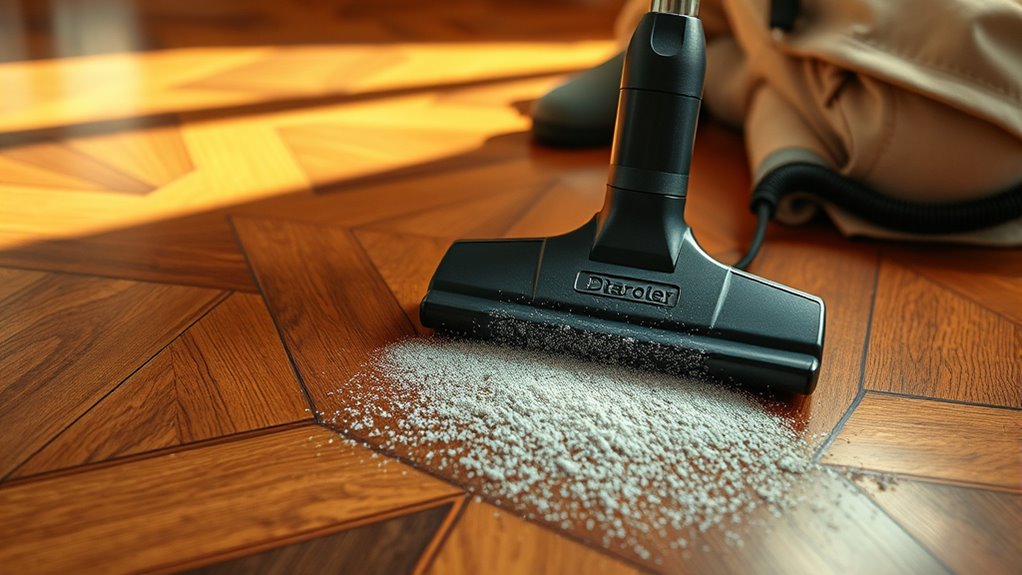
To safeguard your antique floors, start by using soft brush attachments that gently lift dirt without scratching. Keep the vacuum on low suction settings to prevent damage and make sure your movement remains slow and deliberate. This careful approach ensures effective cleaning while preserving the floor’s delicate finish. Additionally, being aware of your local store hours can help you plan cleaning or shopping trips efficiently, avoiding unnecessary delays.
Soft Brush Attachments
Using a soft brush attachment is essential when vacuuming antique floors, as it gently lifts dirt without damaging delicate surfaces. Choosing the right brush ensures you don’t scratch or gouge the finish. Pay attention to brush selection; a natural bristle or microfiber brush works best for gentle cleaning. Adjust your vacuum’s suction control to prevent aggressive pulling on fragile materials. Incorporating professional voiceover techniques can help you better understand how to communicate care instructions effectively.
Consider these tips:
- Use a lightweight, flexible attachment to maneuver easily
- Regularly clean the brush to avoid spreading dirt
- Test suction levels on a small area before full cleaning
These steps help protect your antique floors while maintaining thorough cleanliness. Proper brush selection and suction control are key to achieving a no-scratch, effective vacuuming routine.
Low Suction Settings
Adjusting your vacuum’s suction to a low setting helps protect antique floors from damage. High suction power can pull at delicate surfaces, risking scratches or lifting finishes. By lowering the suction, you reduce the vacuum’s grip on dirt and debris, making it gentler on your floors. Keep in mind that a lightweight vacuum is easier to maneuver, especially on uneven or fragile surfaces. The combination of low suction and a light vacuum weight allows you to clean effectively without exerting excessive pressure. This approach minimizes stress on the flooring, preventing scratches or gouges. Always test the suction setting first, ensuring it’s gentle enough to pick up debris without creating any force that might harm the antique surface.
Mindful Movement Techniques
Practicing mindful movement while vacuuming helps protect your antique floors from unnecessary wear. Focus on slow, deliberate motions to avoid damaging delicate finishes or disturbing floor sealing. Maintain a relaxed grip and use smooth, sweeping strokes to prevent scratches. Incorporate these techniques for ideal results:
- Keep the vacuum head close to the surface, minimizing pressure and friction
- Move steadily to avoid sudden jerks that could loosen aged finishes
- Regularly inspect your vacuum to ensure gentle suction and proper functioning
- Be aware of your cookie preferences, as certain settings may influence your browsing experience and the effectiveness of your cleaning routines.
These mindful movements support antique restoration efforts by reducing floor stress and preserving patina. Gentle vacuuming extends the life of your floors, keeping them in pristine condition without causing damage. When combined with careful cleaning, it ensures your antique floors remain beautiful for generations.
Tips for Avoiding Common Mistakes That Cause Damage

To prevent damaging your antique floors while vacuuming, it’s crucial to avoid common mistakes that can cause harm. Using a vacuum with a rough brush attachment can scratch the surface, so opt for a soft brush or a nozzle designed for delicate floors. Avoid aggressive floor polishing techniques that can strip the finish or create uneven wear. When tackling stains, never use harsh chemicals or abrasive tools, as they can cause lasting damage. Instead, gently spot clean with appropriate solutions to preserve the floor’s integrity. Always check your vacuum’s settings to ensure they’re suitable for antique surfaces. Additionally, considering the benefits of Glycolic Acid in skincare routines highlights the importance of gentle, effective cleaning methods to maintain surface quality. By being mindful of these tips, you can maintain the beauty of your vintage floors and prevent unnecessary damage during routine cleaning.
Regular Maintenance and Care to Preserve Vintage Beauty
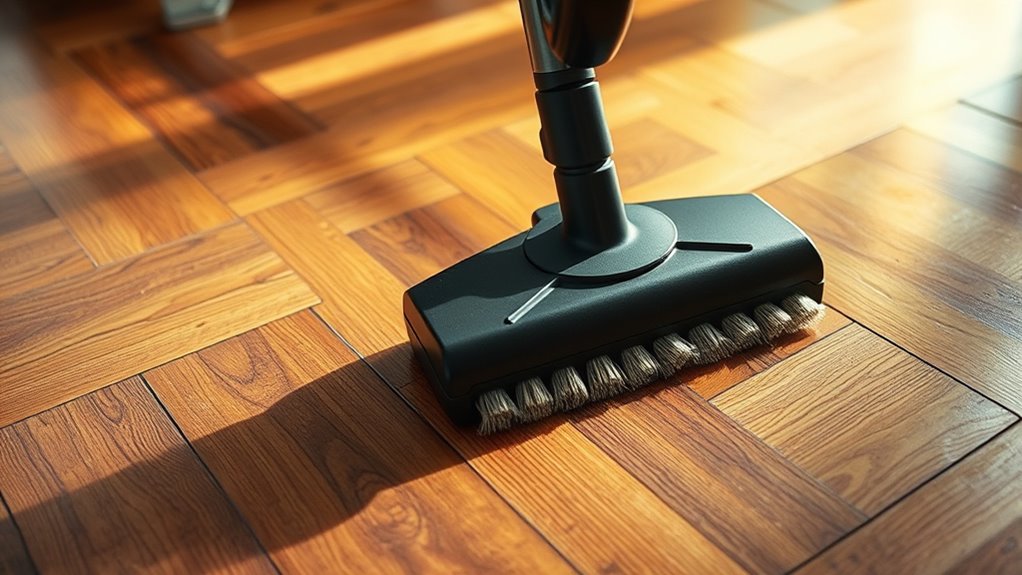
Maintaining the beauty of your antique floors requires consistent care beyond avoiding damage during cleaning. Regular upkeep helps preserve their vintage charm and polished finishes. Use gentle cleaning methods and avoid harsh chemicals that could dull the shine. Incorporate modern appliances, like soft-bristled vacuum attachments, to reduce wear and tear. Additionally, being aware of beekeeping practices can inspire gentle cleaning techniques that protect delicate surfaces.
To keep your floors looking their best, consider these tips:
- Regularly dust with a soft cloth to prevent dirt buildup
- Use appropriate cleaning products designed for vintage wood
- Place protective pads under furniture to prevent scratches
Consistent maintenance prevents unnecessary wear, keeping your floors radiant. Proper care ensures they retain their character, with polished finishes shining through for years to come.
Additional Methods to Complement Vacuuming and Protect Your Floors

In addition to vacuuming, applying protective finishes like wax or polyurethane can further shield your antique floors from scratches and moisture. Floor sealing creates a barrier that prevents dirt, spills, and moisture from penetrating the wood, helping preserve its beauty over time. Regularly sealing your floors reduces the risk of damage and maintains their original charm. If your floors show signs of wear, hardwood refinishing offers a more thorough solution, restoring the surface and enhancing durability. This process involves sanding and applying a fresh finish, which complements your ongoing vacuuming routine. Combining these methods with gentle cleaning ensures your antique floors stay protected, vibrant, and scratch-free for years to come. Proper floor sealing and refinishing are essential steps in maintaining your vintage flooring’s integrity. Support hours for professional assistance are available if you need expert guidance on refinishing or sealing options.
Frequently Asked Questions
Can the No‑Scratch Method Be Used on All Types of Antique Floors?
You might wonder if the no-scratch method works on all antique floors. While it’s gentle and effective for many types, it’s essential to take into account floor type compatibility. Some delicate or porous surfaces could have cleaning method limitations, risking damage. Always test a small area first and check manufacturer guidelines. Using this method carefully ensures you won’t harm your antique floors while keeping them clean and preserved.
How Often Should I Vacuum My Vintage Wood or Tile Floors?
You might think you can vacuum vintage wood or tile floors daily, but that’s a bit overkill. Instead, sticking to a regular maintenance schedule of once a week usually does the trick. This way, you keep dust and debris at bay without risking scratches. Adjust your vacuuming frequency if you notice more dirt or if your floors see heavy traffic, ensuring they stay pristine and well-maintained.
Are There Specific Brands of Vacuums Recommended for Antique Floor Care?
When choosing a vacuum for antique floors, you should look at vacuum filter types like HEPA filters for better air quality and gentle brush rolls to prevent scratches. Your vacuuming frequency depends on foot traffic, but generally, you should vacuum regularly to avoid dirt buildup. Select a lightweight model with adjustable settings to guarantee you clean effectively without damaging your vintage wood or tile floors.
What Signs Indicate My Antique Floors Need Professional Restoration Instead of Cleaning?
You’ll want professional restoration if you notice significant floor discoloration that won’t improve with cleaning. Surface cracks that deepen or spread over time also signal underlying damage needing expert attention. If your antique floors lose their luster despite careful cleaning, or if you see areas where the finish is peeling or the wood is splintering, it’s best to consult a professional to preserve and restore their original beauty.
Can This Method Be Safely Combined With Waxing or Sealing Treatments?
They say, “Look before you leap,” and that’s true when combining cleaning methods with waxing or sealing. You should verify wax compatibility and sealing considerations first, as some products might damage your antique floors. Always test a small area first, and consult product instructions. Using gentle, compatible products ensures your floors stay beautiful without risking harm, preserving their charm for years to come.
Conclusion
By following these gentle vacuuming tips, you’re preserving your antique floors’ timeless beauty. But remember, the real challenge lies ahead—what hidden secrets might your floors reveal if you stay consistent and cautious? Keep practicing the no-scratch method, and you might just uncover a vintage charm that lasts for generations. Are you ready to take your floor care to the next level and discover their full story? The next step awaits—don’t miss it.



